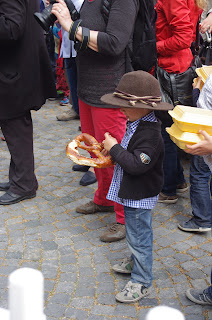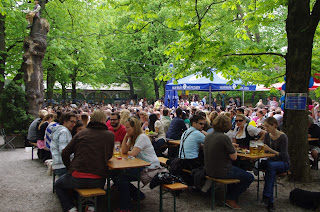I was back to the third home town of Munich at the end of Munich. Many of my friends and colleagues said that it was good timing because it should be well into spring and the weather should be warmer, especially a long and harsh winter. However, the warmer times haven’t really settled in yet and winter is always lurking in a dark corner somewhere. The warmer clothes that I packed proved to be more useful than I expected.
四月底我又回到第三故鄉慕尼黑,不論同事和友人都不約而同說我來的時間正好,剛好春回大地。以「春回大地」形容四月底五月初乍聽下有點晚,但各人都說剛過去的冬天特別長,而且最近天氣還不太穩定,乍暖還涼,帶來的衣物中,還是保暖的較用得著。
Spring is indeed a time when nature springs into life from hibernation. This time I’m staying in the northern fringe of the Munich city area and surrounded by a lot of greenery. The transition into spring was best manifested in the row of trees that I can see from my window. The bare branches at the time of moving in were slowly sprouting new foliages, and within a month covered by dense layers of leaves. The trees provide a good shade for kids playing football in the courtyard and a place for birds to stop by. It was so refreshing and soothing to hear bird songs after one week of hustle and bustle in Hong Kong followed by incessant honking in Hefei before arriving in Munich!
春天的確是生氣盅然的時節,是次住在慕尼黑市區邊錘,居室外盡見一排排的樹,從我剛搬進來時光禿禿的,漸次長出新葉,沒多久便蔥鬱茂密一片。下班後望窗外不時有一群群小孩在樹下的草地踢球,閒時也聽到婉轉的鳥聲,跟來慕尼黑前在香港的熙攘和合肥一天到晚的汽車鳴笛聲相比(有機會補寫),身心當下鬆弛了。



The green transformation
綠色的變身
Spring is also a time when nature changes in a blink. The cherry and peach blossoms are the reminders of how fickle spring can be. Trees that were in full blossom of pink or white would turn completely green in a matter of days, with all the flowers given way to leaves. The dropping of the white petals in the spring breeze would sometimes even look like snowfall in spring as the petals danced and drifted like snowflakes in the air in large amounts.
春天也是瞬息萬變的時候,除了天氣外,最顯而易見的就是桃花和梨花樹,剛來到時還有不少滿樹開花,但不出三數天便換成一片綠葉,有時看到白花瓣被陣陣風從樹上吹到四散飛,乍看下還會有種春天飄雪的感覺。


Peach and cherry blossoms 梨花和桃花

Colourful combinations
不同的配搭


Almost like snow
像下雪嗎?
A couple of my friends are really into photography and flowers, and one Sunday they suggested that I should join them to the Botanischer Garten (Botanical Garden) near Schloss Nymphenburg (Nymphenburg Castle) for the tulips and other flowers before they would all wilt. One of the courtyards in the Garden has turned into a sea of tulips in Technicolor and different shapes like star-shaped or in a cluster apart from the normal cusp shape. The palette of colours was amazing especially in the many shades of red and orange. The rest of the Garden was laid out with beautiful landscaping. We walked up a small hill planted with many different types of flowers normally found at high altitudes, then down to a pond and along the leafy paths which were also full of flowers. Finally we visited the greenhouses which exhibited such an extensive variety of plant species from all over the world that 1 ½ hours were clearly too short!
有朋友喜歡賞花和攝影,告訴我賞春花的時日不多,便邀約我到寧芬堡城堡(Schloss Nymphenburg)附近的植物花園(Botanischer Garten)看鬱金香和其他花卉。花園內其中一個庭園的所有花坪,種植了七彩繽紛、形態不一的鬱金香,除了大家熟悉酒杯狀的花外,也有星形的、球狀的不等,顏色也呈多種層次,活像一塊天然的調色板。花園內還有些園林景緻,走上一個用以種植高山花卉的小山後,下山沿著小池塘和林蔭小道緩步欣賞各種各類的植物,再進入溫室觀賞更多來自全球的多個特別品種,但在溫室祇有短短個多小時實在不夠呢!




Different parts of the garden 花園的不同部分


Through the flower beds 花叢中

The pond and the little hill
有山有水的花園
Draped in green
驟看有種林深不知處的感覺

Orchids in the greenhouse
溫室內的蘭花


Bamboos and palms(?) in the greenhouse
溫室內的棕櫚(?)和竹樹
Trees and flowers were not the only things that symbolise a new beginning. In many districts of Munich city, suburbs near Munich, villages in Bavaria and indeed farther afield in Europe, the time about 1st May is marked by the erection of new May poles (called Maibaum in German) which is an age-old tradition to celebrate the arrival of spring. One of my friends who invited me to the Botanischer Garten met me for lunch on 1st May. En route on the underground I noticed many people wearing traditional clothes alighting at the station before my stop, and I was curious to find out what it was about form my friend. At first she thought that they were simply trying to make use of the good weather in some beer gardens in the neighbourhood, so she took me to the nearby Wiener Platz. We were lucky enough to come in time to witness the erection of the May pole. Traditionally the May pole is pulled up by muscle power, but a fire engine did the job that day. After the fire fighters certified that the May pole was safe, a traditional Bavarian band started playing music to entertain the crowd drinking in the makeshift beer garden at Wiener Platz. It made for a jolly atmosphere on an important tradition occasion.
象徵新開始的,除了花卉外,在慕尼黑市內部分小區、市郊、拜恩州的村落,以至歐洲不少地方,五月一日前後都會豎立新的五朔節花柱(Maibaum),寓意春回大地的新開始。五月一日那天友人約我吃午飯,坐地鐵前往時發現不少穿傳統服裝的男女老幼在我前一站下車,便問朋友是啥回事,起初朋友還以為祇是不少人趁公眾假期天氣好到啤酒園享受好時光,飯後便帶我往那一帶的Wiener Platz,不祇有啤酒園,還剛好遇上花柱豎立的儀式。傳統的花柱要靠人手拉起,但那裡有消防吊車代勞,待消防確認安裝是安全後,還有傳統樂隊伴奏,為現場增添不少喜氣洋洋的氣氛!


A special fire service duty: erection of the Maibaum followed by safety approval
消防特殊任務:豎立五朔節花柱後驗收


Out in force - in their traditional Trachten clothing
傳統服飾,隨街可見

A true 'Münchner Kindl' (Munich child) with a traditional hat, blue and white chequered shirt and brezl bread (pretzel) - all symbolising Bavaria
穿藍白格襯衣、戴傳統絨帽、拿著圓圈麵包的小孩,正是本地傳統典範

Music and beer: vital ingredients for such a festivity
節慶不少得的音樂和啤酒
Although May poles are common enough sights around Munich, it was actually my first time seeing its erection. Munich is familiar enough to me, but I still manage to uncover many parts that I have never set foot on. Just let me find time to write about them!
五朔節花柱我在慕尼黑看過好些,但豎立的過程倒是第一次目睹。其實慕尼黑對我來說應該不陌生,但這次讓我發掘的東西可多呢,讓我容後再寫吧。
四月底我又回到第三故鄉慕尼黑,不論同事和友人都不約而同說我來的時間正好,剛好春回大地。以「春回大地」形容四月底五月初乍聽下有點晚,但各人都說剛過去的冬天特別長,而且最近天氣還不太穩定,乍暖還涼,帶來的衣物中,還是保暖的較用得著。
Spring is indeed a time when nature springs into life from hibernation. This time I’m staying in the northern fringe of the Munich city area and surrounded by a lot of greenery. The transition into spring was best manifested in the row of trees that I can see from my window. The bare branches at the time of moving in were slowly sprouting new foliages, and within a month covered by dense layers of leaves. The trees provide a good shade for kids playing football in the courtyard and a place for birds to stop by. It was so refreshing and soothing to hear bird songs after one week of hustle and bustle in Hong Kong followed by incessant honking in Hefei before arriving in Munich!
春天的確是生氣盅然的時節,是次住在慕尼黑市區邊錘,居室外盡見一排排的樹,從我剛搬進來時光禿禿的,漸次長出新葉,沒多久便蔥鬱茂密一片。下班後望窗外不時有一群群小孩在樹下的草地踢球,閒時也聽到婉轉的鳥聲,跟來慕尼黑前在香港的熙攘和合肥一天到晚的汽車鳴笛聲相比(有機會補寫),身心當下鬆弛了。



The green transformation
綠色的變身
Spring is also a time when nature changes in a blink. The cherry and peach blossoms are the reminders of how fickle spring can be. Trees that were in full blossom of pink or white would turn completely green in a matter of days, with all the flowers given way to leaves. The dropping of the white petals in the spring breeze would sometimes even look like snowfall in spring as the petals danced and drifted like snowflakes in the air in large amounts.
春天也是瞬息萬變的時候,除了天氣外,最顯而易見的就是桃花和梨花樹,剛來到時還有不少滿樹開花,但不出三數天便換成一片綠葉,有時看到白花瓣被陣陣風從樹上吹到四散飛,乍看下還會有種春天飄雪的感覺。


Peach and cherry blossoms 梨花和桃花

Colourful combinations
不同的配搭


Almost like snow
像下雪嗎?
A couple of my friends are really into photography and flowers, and one Sunday they suggested that I should join them to the Botanischer Garten (Botanical Garden) near Schloss Nymphenburg (Nymphenburg Castle) for the tulips and other flowers before they would all wilt. One of the courtyards in the Garden has turned into a sea of tulips in Technicolor and different shapes like star-shaped or in a cluster apart from the normal cusp shape. The palette of colours was amazing especially in the many shades of red and orange. The rest of the Garden was laid out with beautiful landscaping. We walked up a small hill planted with many different types of flowers normally found at high altitudes, then down to a pond and along the leafy paths which were also full of flowers. Finally we visited the greenhouses which exhibited such an extensive variety of plant species from all over the world that 1 ½ hours were clearly too short!
有朋友喜歡賞花和攝影,告訴我賞春花的時日不多,便邀約我到寧芬堡城堡(Schloss Nymphenburg)附近的植物花園(Botanischer Garten)看鬱金香和其他花卉。花園內其中一個庭園的所有花坪,種植了七彩繽紛、形態不一的鬱金香,除了大家熟悉酒杯狀的花外,也有星形的、球狀的不等,顏色也呈多種層次,活像一塊天然的調色板。花園內還有些園林景緻,走上一個用以種植高山花卉的小山後,下山沿著小池塘和林蔭小道緩步欣賞各種各類的植物,再進入溫室觀賞更多來自全球的多個特別品種,但在溫室祇有短短個多小時實在不夠呢!




Different parts of the garden 花園的不同部分


Through the flower beds 花叢中

The pond and the little hill
有山有水的花園
Draped in green
驟看有種林深不知處的感覺

Orchids in the greenhouse
溫室內的蘭花


Bamboos and palms(?) in the greenhouse
溫室內的棕櫚(?)和竹樹
Trees and flowers were not the only things that symbolise a new beginning. In many districts of Munich city, suburbs near Munich, villages in Bavaria and indeed farther afield in Europe, the time about 1st May is marked by the erection of new May poles (called Maibaum in German) which is an age-old tradition to celebrate the arrival of spring. One of my friends who invited me to the Botanischer Garten met me for lunch on 1st May. En route on the underground I noticed many people wearing traditional clothes alighting at the station before my stop, and I was curious to find out what it was about form my friend. At first she thought that they were simply trying to make use of the good weather in some beer gardens in the neighbourhood, so she took me to the nearby Wiener Platz. We were lucky enough to come in time to witness the erection of the May pole. Traditionally the May pole is pulled up by muscle power, but a fire engine did the job that day. After the fire fighters certified that the May pole was safe, a traditional Bavarian band started playing music to entertain the crowd drinking in the makeshift beer garden at Wiener Platz. It made for a jolly atmosphere on an important tradition occasion.
象徵新開始的,除了花卉外,在慕尼黑市內部分小區、市郊、拜恩州的村落,以至歐洲不少地方,五月一日前後都會豎立新的五朔節花柱(Maibaum),寓意春回大地的新開始。五月一日那天友人約我吃午飯,坐地鐵前往時發現不少穿傳統服裝的男女老幼在我前一站下車,便問朋友是啥回事,起初朋友還以為祇是不少人趁公眾假期天氣好到啤酒園享受好時光,飯後便帶我往那一帶的Wiener Platz,不祇有啤酒園,還剛好遇上花柱豎立的儀式。傳統的花柱要靠人手拉起,但那裡有消防吊車代勞,待消防確認安裝是安全後,還有傳統樂隊伴奏,為現場增添不少喜氣洋洋的氣氛!


A special fire service duty: erection of the Maibaum followed by safety approval
消防特殊任務:豎立五朔節花柱後驗收


Out in force - in their traditional Trachten clothing
傳統服飾,隨街可見

A true 'Münchner Kindl' (Munich child) with a traditional hat, blue and white chequered shirt and brezl bread (pretzel) - all symbolising Bavaria
穿藍白格襯衣、戴傳統絨帽、拿著圓圈麵包的小孩,正是本地傳統典範

Music and beer: vital ingredients for such a festivity
節慶不少得的音樂和啤酒
Although May poles are common enough sights around Munich, it was actually my first time seeing its erection. Munich is familiar enough to me, but I still manage to uncover many parts that I have never set foot on. Just let me find time to write about them!
五朔節花柱我在慕尼黑看過好些,但豎立的過程倒是第一次目睹。其實慕尼黑對我來說應該不陌生,但這次讓我發掘的東西可多呢,讓我容後再寫吧。




Comments